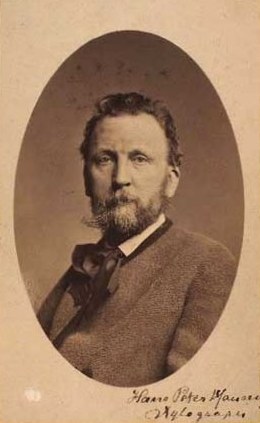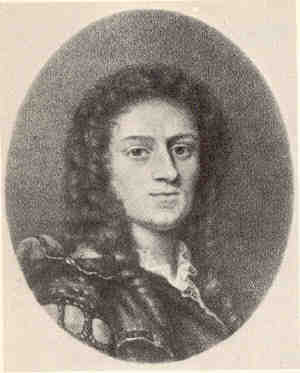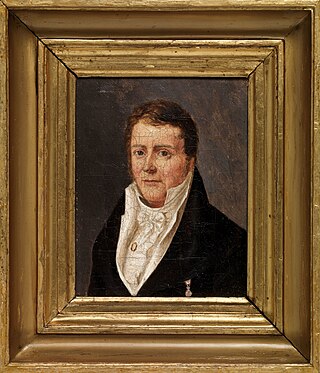
Johan Peter Emilius Hartmann was, together with his son-in-law Niels W. Gade, the leading Danish composer of the 19th century, a period known as the Danish Golden Age. According to Alfred Einstein, he was "the real founder of the Romantic movement in Denmark and even in all Scandinavia". J.P.E. Hartmann was the third generation of composers in the Danish musical Hartmann family.

Hans Peter Hansen was a Danish xylographer who specialized in portraits.

Martin Nyrop was a Danish architect.

Gl. Holtegaard is a former Manor house in Rudersdal Municipality north of Copenhagen, Denmark, today operated as an arts centre and a museum. It was built by the Danish Baroque architect Lauritz de Thurah (1706–1759), for his own use in 1757. Its original Baroque gardens were reconstructed in 2003.

Johan Frederik Møller, also J. F. Møller, was a Danish painter and photographer.

Johann Gottfried Becker was a Danish pharmacist. He served as court pharmacist for Frederick III and opened the Elephant Pharmacy on Købmagergade in Copenhagen in 1670.
Johan Rudolph Thiele was a Danish book printer. He founded a successful printing business in Copenhagen in 1771 which was later continued as H. H. Thiele by his son Hans Henrik Thiele. The company survived until 1937. Another son, Frederik Anton Thiele, founded N. A. Thiele, a manufacturer and retailer of scientific instruments which would later develop into one of Denmark's leading chains of retail opticians under the name Thiele. A third son was the art historian and writer Just Mathias Thiele.

Martin Johannes Hammerich was a Danish art historian, educator, author and translator. He was part of the National Liberal movement and a member of the 1848 Danish Constituent Assembly. He was headmaster of Borgerdydskolerne from 1842 to 1867.

Holger Petersen was a Danish businessman and philanthropist.

Hans Heinrich Baumgarten was a Holstein-Danish industrialist. In 1843, he founded a company which from 1846 became known as Baumgarten & Burmeister and after his retirement became Burmeister & Wain.

Bianco Luno was a Danish book printer. His printing business, Bianco Lunos Bogtrykkeri, was at the time of his death in 1852 the largest company of its kind in Denmark. The street Bianco Lunos Allé in Frederiksberg is named after him.

Vilhelm Prior was a Danish book dealer and publisher. He was awarded the title book dealer to the Greek court in 1876 and to the Danish court in 1906. His book shop was from 1875 based at Købmagergade 52 in Copenhagen.

Axel Theodor Kittendorff was a Danish xylographer.

Johan Ludvig Ammentorp was a Danish medical doctor. He served as Chief Physician of the Medical Corps (stabslæge) from 1911 and as Physician General (generallæge) from 1916 to 1930.
Hans Qvist was a Danish engraver.

Hans Christopher Georg Friederich Hedemann (1792–1859) was a Danish officer who became lieutenant general in the Danish army.

Peter Christian Uldahl was a Danish piano maker. He started Denmark's first piano factory in Copenhagen in 1809. Just under 600 instruments left the factory during its 11 years of existence. A giraffe piano from the factory is in the collection of the Danish Music Museum.

Wilhelm Wanscer was a Danish paper merchant and art collector, remembered above all for his associations with the philosopher Søren Kirkegård and some of the leading Danish Golden Age artists. He was the father of surgeon Oscar Wanscher and industrialist Axel Wanscher, grandfather of art historian Vilhelm Wanscher and great-grandfather of the designer Ole Wanscher.

Pilestræde 37/Kronprinsensgade 13 is an 18th-century building situated at the acute-angled corner of Pilestræde and Kronprinsensgade in the Old Town of Copenhagen, Denmark. It was listed in the Danish registry of protected buildings and places in 1945. It was constructed by the master mason and developer Johan Peter Boye Junge, who also constructed the buildings at Pilestræde 39–47 in conjunction with his creation of the street Kronprinsensgade, and who was himself a resident of the building from its completion in 1786. Other notable former residents include actors Michael and Johanne Rosing, printer Andreas Flinch, poet Christian Winther and Bing & Grøndahl co-founder Meyer Herman Bing.
Johan Adolph Frederik Stramboe was a Danish ballet dancer.


















